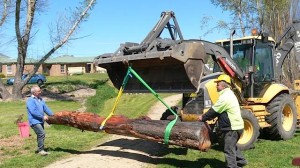What does it take to relocate a platypus?
Tony Evans and Shane Brown from ULSC steadies the log for relocation to its new place.
The chainsaw art platypus was in need of a more prominent location overlooking the ‘pool of reflection’ further along the riverbank, where it also would not be in the way of lawn mowing. The heavy machinery was provided by ULS Council’s Jessie Croker and Shane Brown, and the team of concreters/workers by Cr. Malcolm Barlow, Tony Evans, Barry Murphy, Jim Gay and David Guy.
Big machinery was used to carefully relocate the Platypus to its new location.
As for the real platypus of the area, Ornithorhynchus anatinus.
There has been sightings since the undertaking of willow removal and creek restoration works.
Studies have shown that the presence of platypus is related to the amount of indigenous vegetation growing along healthy waterways.
When willows and weeds spread along creeks and riverbanks they can displace native vegetation and choke waterways, depleting oxygen and creating unsuitable conditions for many native species, including the aquatic invertebrates that platypus feed upon.
Playtypus can travel many kilometres in night long feeding sessions but choked waterways , particularly those with a mesh of numerous willow root systems, can prevent them from swimming, feeding and digging burrows.
If waterways are not managed properly localised extinctions can occur.
However platypus have a strong association with indigenous native trees, large logs and woody debris which provide shelter from predators and also the correct habitat for the aquatic invertebrates that platypus eat.
A healthy breeding population is also an indicator of good water quality and habitat . It may have been coincidental that the platypus relocation occurred in the first week in October, but this week celebrates both World Animal Day and World Habitat Day.
A timely reminder that looking after nature benefits both wildlife and ourselves. Looking after our creeks and neighbouring reserves will improve water quality, increase habitat for local wildlife and increase the network of green open space and walking trails for all to enjoy.
It is hoped in the future that wheelchair access to Kiamma Creek will be available at Pat Cullen Memorial Reserve.
All are welcome to also attend the opening of the Memorial Rose Garden on November 11 at 11.00 am.
Cup of tea on the banks of the Kiamma Creek after the relocation of the Platypus.
in the Crookwell Gazette http://www.crookwellgazette.com.au/story/2608316/what-does-it-take-to-relocate-a-platypus/?cs=12








